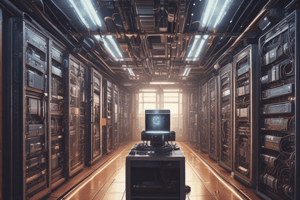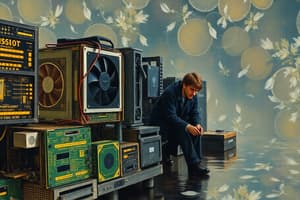Podcast
Questions and Answers
Which of the following best describes the role of the operating system in a computer?
Which of the following best describes the role of the operating system in a computer?
- Creating documents and spreadsheets.
- Connecting to the internet.
- Controlling hardware components and managing connected devices. (correct)
- Playing video games.
The CPU directly accesses data from secondary storage devices (like hard drives) to run programs.
The CPU directly accesses data from secondary storage devices (like hard drives) to run programs.
False (B)
Explain the relationship between hardware and software in a computer system.
Explain the relationship between hardware and software in a computer system.
Hardware provides the physical components of a computer, while software provides the instructions that tell the hardware what to do.
A ________ is a set of instructions that a computer follows to perform a task.
A ________ is a set of instructions that a computer follows to perform a task.
Match the following components with their primary function:
Match the following components with their primary function:
Which of the following is an example of application software?
Which of the following is an example of application software?
Utility programs are designed to manage the basic operations of the computer.
Utility programs are designed to manage the basic operations of the computer.
Explain the role of a programmer in the context of computer software.
Explain the role of a programmer in the context of computer software.
Which of the following best explains the primary function of the BIOS (Basic Input Output System) during the computer boot process?
Which of the following best explains the primary function of the BIOS (Basic Input Output System) during the computer boot process?
A single byte can store any integer value between 0 and 1023, inclusive.
A single byte can store any integer value between 0 and 1023, inclusive.
What is the role of an assembler in the context of programming languages?
What is the role of an assembler in the context of programming languages?
In the CPU execution cycle, the process of determining which operation to perform based on the fetched instruction is known as ______.
In the CPU execution cycle, the process of determining which operation to perform based on the fetched instruction is known as ______.
Match the following data storage units with their corresponding size or description:
Match the following data storage units with their corresponding size or description:
Which of the following programming languages is considered a low-level language?
Which of the following programming languages is considered a low-level language?
Keywords in a high-level programming language are user-defined words that are used to name variables and functions.
Keywords in a high-level programming language are user-defined words that are used to name variables and functions.
What is the maximum value that can be stored in two bytes?
What is the maximum value that can be stored in two bytes?
Explain the roles of 'fetch', 'decode', and 'execute' in the CPU instruction cycle.
Explain the roles of 'fetch', 'decode', and 'execute' in the CPU instruction cycle.
A digital image is composed of ______, and each of these is converted to a binary number representing its color for storage.
A digital image is composed of ______, and each of these is converted to a binary number representing its color for storage.
Flashcards
Program
Program
Set of instructions a computer follows to perform a task.
Programmer
Programmer
Person who designs, creates, and tests programs.
Hardware
Hardware
Physical devices that comprise a computer system.
CPU
CPU
Signup and view all the flashcards
RAM
RAM
Signup and view all the flashcards
Secondary Storage Devices
Secondary Storage Devices
Signup and view all the flashcards
Operating System
Operating System
Signup and view all the flashcards
Utility Program
Utility Program
Signup and view all the flashcards
Software Development Tools
Software Development Tools
Signup and view all the flashcards
BIOS
BIOS
Signup and view all the flashcards
Bit
Bit
Signup and view all the flashcards
Byte
Byte
Signup and view all the flashcards
Binary Number System
Binary Number System
Signup and view all the flashcards
Fetch-Decode-Execute Cycle
Fetch-Decode-Execute Cycle
Signup and view all the flashcards
Low-Level Languages
Low-Level Languages
Signup and view all the flashcards
High-Level Languages
High-Level Languages
Signup and view all the flashcards
Operators
Operators
Signup and view all the flashcards
Syntax
Syntax
Signup and view all the flashcards
Study Notes
Computer Components and Operation
- Computers combine mechanical and electrical parts to run programs, sets of instructions for tasks.
- Programmers design, create, and test programs/software
- Hardware consists of the physical computer components.
Major Computer Components
- CPU (Central Processing Unit): Runs programs, located on small microprocessors.
- Main Memory (RAM): Stores programs and data while running; quickly accessible by the CPU; erased when the computer is off.
- Secondary Storage: (e.g., hard drives, SSDs, UBS drives, optical discs) Stores data for long periods; where programs are usually stored.
- Input Devices: (e.g., keyboard, mouse, camera) Collect data for the computer. Disk drives can also be input devices.
- Output Devices: (e.g., printer, monitor, speakers) Produce data for other devices. Disk drives/USBs can also be output devices.
- Communication Devices: (e.g., modems, routers, hubs) Connect computers and devices.
Computer Software
- Software: Controls everything a computer does.
- Application Software: Programs for everyday tasks (e.g., word processing, email, web browsers, games).
- System Software: Controls and manages basic computer operations.
- Operating System: (e.g., Windows, MacOS, Android, iOS) Manages hardware, devices, storage, and program execution .
- Utility Programs: Enhance computer operation or safeguard data (e.g., virus scanners, backup programs).
- Software Development Tools: Used for creating, modifying and testing software programs (e.g., assemblers, compilers, interpreters).
- BIOS (Basic Input/Output System): Firmware that initializes hardware operations and manages data flow to/from the OS during bootup, acting as an interface between the hardware and the OS. Stored in ROM on the motherboard.
Data Storage
- All computer data is stored as sequences of 0s and 1s.
- Byte: Enough memory to store a letter or small number; comprised of 8 bits.
- Bit: An electrical component representing an on/off switch (positive/negative charge).
- Byte size limits: 0 to 255 (with one byte), 0 to 65535 (with two bytes)
- Data types:
- Digital: Stores data as binary numbers.
- Digital Images: Composed of pixels, each converted to a binary number representing its color (RGB).
- Digital Music: Composed of samples, each converted to a binary number.
Program Execution
- CPUs perform simple operations (reading, adding, subtracting, etc.) on data.
- Each CPU has a unique instruction set.
- Programs are copied from secondary storage to RAM before execution.
- CPU executes programs in a cycle:
- Fetch: Retrieve the next instruction from memory.
- Decode: Understand which operation to perform.
- Execute: Carry out the operation.
Programming Languages
- Low-Level Languages: (Machine Language & Assembly Language) Close to binary code.
- Assembly Language: Uses mnemonics (short words) for instructions, making it easier for programmers.
- Assembler: Translates assembly language to machine language.
- High-Level Languages: Intuitive languages allowing creation of complex programs without needing detailed CPU knowledge (e.g., Python).
- Keywords: Predefined words with specific meanings.
- Operators: Perform operations on data (e.g., Math operations).
- Syntax: Set of rules for writing programs.
- Statement: Individual instruction in a high-level language.
Studying That Suits You
Use AI to generate personalized quizzes and flashcards to suit your learning preferences.




